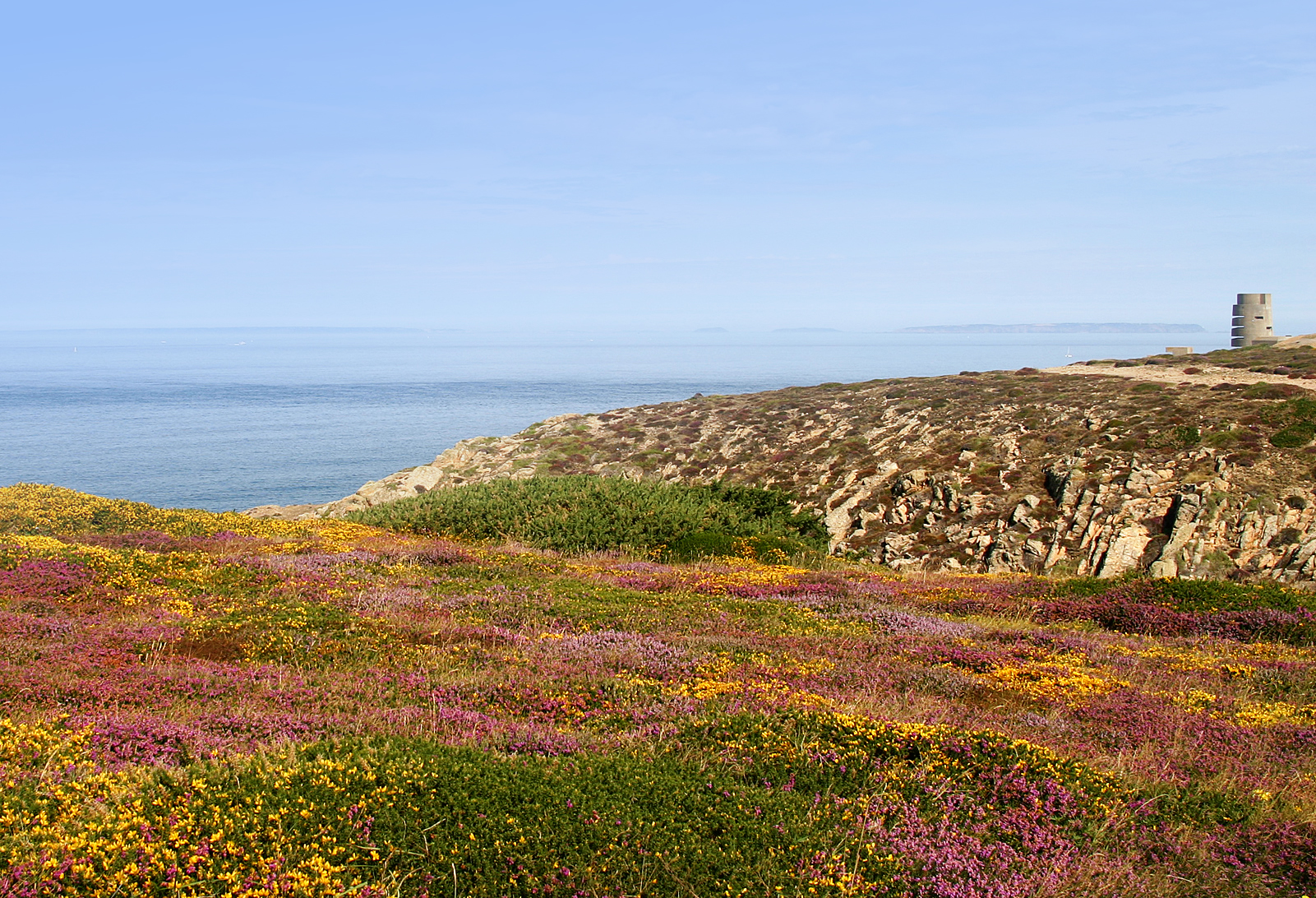Alderney
The pair of choughs seen in Alderney on 31st March continued to reside there into April. This news was shared by Alderney Bird Observatory (ABO). It’s great to know we have eyes and ears on the neighbouring islands, where choughs are concerned. Both female and hatched in 2023, these birds were identified as: Skomer (Black/Pink (L)) and Millport (Dark Blue/Pink (R)). Always observed together, they were also seen allopreening. Their spontaneous ‘girls trip’ to Alderney could have been to scout for some males, as unfortunately, the sex ratio in the flock has more females than males. Having failed in their endeavour, the pair returned to Jersey on 10th April.
The first of many
The first chick of the year was ringed on 1st May. This chick was from a new breeding pair, Alder & Angalsea, at a new nesting location. The male, Alder, hatched in 2022, and the female, Angalsea, in 2023. This young pair is rarely seen at the Sorel aviary during supplementary feeding times, so it was a big surprise when we received information on their success. The team set off, found the pair, their nest and chick! Although they only had one chick this year, we hope that in the coming years they will become more experienced and successful.
This year’s ring colour is: Brown. It will be coupled with three other individual identifier bands. The long-debated chough naming theme this year is: Biscuits, which turns out to be quite fitting as the biscuits brand McVitie’s is celebrating their 100th anniversary!
New nest findings
The team has been working hard to find more chough nests across the island. With the help of Jersiaise ornithology members as well as Jersey residents, the team at Durrell has received more chough sightings, which in turn has helped narrow down the search for nest locations. This year, three new nests were located. The first nest was located in L’Etacq, which was breeding pair Alder and Angalsea’s nest. The second nest was found through word of mouth on social media. We contacted the landowners and they happily allowed us to monitor the nest, enabling us to establish the pair visiting were Portelet & Sallow. The third nest was also found in St Ouen and with landowners again giving us access, we concluded the third nest site belonged to Aspen & Jaune.
The nests found in St Ouen were unfortunately inaccessible without cherry pickers. The location of Sallow & Portelet’s nest was well hidden, but the landowners managed to send us regular nest updates, allowing us to know how many chicks to expect from them. Their nest contained four chicks!
Aspen & Jaunes nest could luckily be viewed from the ground, and they had two hungry chicks to feed. If any of the readers know of a chough nest site, please do not hesitate to email us at charlotte.dean@durrell.org as we’re eager to find out where all the choughs nest for future monitoring.
Ronez First walk around
Our first quarry walk around was on the 16th May – this is when we look around accessible chough nests to estimate chick ages so we can plan leg ringing sessions. The nests we could look into were Kevin & Wally, Dusty & Archirondel, and Iris & Sercq’s. Kevin & Wally had three chicks of ringing age; therefore, we ringed them on site. Dusty & Archirondel looked as though they had two chicks in their nest. Sercq & Iris had two much younger looking chicks than the other two pair’s nests we visited. Although we could only access three nests, we could hear chicks in other nests when walking around the site.
Ronez ringing visit
The chough team visited Ronez again on the 25th May for the chough ringing visit. Our visit would not be possible without our collaboration with Ronez, as well as the generosity of 4Hire for allowing us the use of essential equipment to access nests free of charge. A total of seven nests were seen at the quarry this year, with six being accessible. Three of those nests required a cherry picker, and one required a scissor stair lift.
The first nest accessed was a new pairing; Percy & Remi. Percy & Remi had three hungry chicks in their nest, but unfortunately the weather was against us, so the chicks were left undisturbed. The second nest was another new pairing; Lee & Elm who had two chicks in their nest. The third nest was breeding pair Trevor & Noirmont, containing two chicks. The fourth nest investigated using the cherry picker was empty. The fifth nest was Dingle & Pyrrho’s, and this nest was accessed with a scissor lift.
One chick was found in the high nest, however chick calls were heard close by while this chick was being ringed. The staff explored around the nest site and found three newly fledged chicks hiding under a cupboard! The sixth and last nest investigated belonged to Sercq & Iris, and two chicks were noted.
Plemont pair
The pair at Plemont weren’t visited as much this breeding season due to the stairs to the beach being replaced. However, once access was granted again, we managed a few afternoon observations. We also had some helpful Jersey residents monitoring the nest in our absence. Minty & Reys four chicks were witnessed leaving their nest for the very first time on 5th June and brought all four fledglings to the aviary on 11th June.
Table 1, number of chicks in each nest visited so far.
|
Breeding pair |
Number of chicks in nest |
|
Alder & Angalsea |
1 |
|
Kevin & Wally |
3 |
|
Percy & Remi |
3 |
|
Lee & Elm |
2 |
|
Trevor & Noirmont |
2 |
|
Dingle & Pyrrho |
4 |
|
Sercq & Iris |
2 |
|
Dusty & Archirondel |
2 |
|
Aspen & Jaune |
2 |
|
Sallow & Portelet |
4 |
|
Minty & Rey |
4 |
|
Bo & Flieur |
Unknown |
|
Pinel & Vicq |
Unknown |
|
Sarnia & Pine |
Unknown |
|
Kent & Rougenez |
Unknown |
|
Oronsay & Manitou |
Unknown |
|
Feta & Manchego |
Unknown |
|
Total |
29 |
First ‘choughlets’ at the aviary
On the 5th June, the first pair to bring chicks near the aviary was Dingle & Pyrrho. Though the flyover was brief, the team spotted them. The next pair were Kevin & Wally, with two of their three chicks on 10th June. Minty & Rey brought their four chicks on the 11th June, who looked to be quite a handful! Dusty & Archirondel brought two chicks on 13th June, with Lee & Elm bringing their two chicks a little later on 17th. On the 18th, Sercq & Iris brought one chick, Sallow & Portelet brought three chicks, and Trevor & Noirmont brought two. Aspen & Jaune were seen feeding two chicks at the aviary on 20th June. Percy & Remi brought 3 chicks to the aviary on 21st June. Alder & Angalsea brought their chick to the aviary on 22nd. Finally, on the 25th June, Bo & Flieur surprised us when they were seen feeding a chick!
Where have you seen the choughs?
April saw the most frequent sightings of choughs in St Ouen, which varied from inland sightings to observations along the coast. The highest number of choughs seen in a flock at St Ouen was seven in some horse fields along Mont Matthieu. The largest flock seen was 15 over Sorel. Choughs were however seen in many places around the island, including: Plemont, Corbiere, St Helier, Les Landes, Trinity, L’Etacq, Grosnez, Greve de Lecq, Grouville, Petit Port and St Catherine’s.
St Ouens seems to be the place to spot choughs lately. Choughs were seen most often during May – whether that be near the pond or further inland. The largest flock seen around the island was 23, flying over towards Ronez. Corbiere also saw 21 choughs. Apart from St Ouen, Ronez and Corbiere, the choughs were also spotted in various other places such as: Crabbe, Plemont, Les Landes, Grosnez, Le Pulec, Petit Port and White Rock.
Corbiere seemed to be the most popular place to see choughs in June. The three main places they were sighted were near the radio tower, in the Gorselands and La Rosiere quarry. The second most popular areas were Plemont and Les Landes. The largest flock was spotted in flight over Les Landes. However, the choughs were also seen in St John, St Ouens, St Mary’s, Grosnez, Greve de Lecq and Petit Port.
Conservation Awards 2025
Durrell was invited to attend the 35th Jersey Conservation Awards anniversary as a potential candidate for a chance to win an award for conservation efforts across Jersey. This year’s event had several categories: School & youth group green award, Young conservationist of the year, People’s choice award, Best conservation project runner up and best conservation award. Each candidate entered gave a presentation on their projects. It was inspiring to hear about the fantastic conservation work that is on-going around the island. Durrell was lucky enough to receive the ‘Best conservation project award’ for the Red-Billed Chough Project.

Durrell Bird Team members accepting ‘The best conservation project’ 2025 for the Red-Billed Chough Project. Photograph by: Paul Wright.
Durrell’s Species Champion Award (DSCA)
Durrell’s education and chough team collaborated on a week-long event in June, where year 6 pupils of St John’s school took part in Durrell’s Species Champion Award (DSCA). The DSCA aimed to engage schools and local communities in wildlife conservation as well as to find better connections with nature. St John’s school chose the charismatic Red-billed Chough as their species champion and therefore were educated on the species through activities between 23rd – 27th June. The chough team gave a talk on the Red-billed Chough Project. During the week, the children learnt about ecosystems, chough diet, chough legends, created posters on the species, as well as taking a field trip to the Sorel aviary. They ended their week ‘championing’, by sharing what they had learnt with a reception class and their families.





































